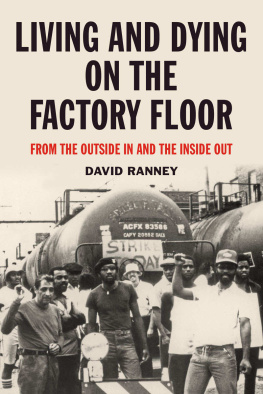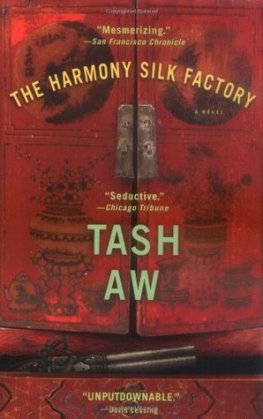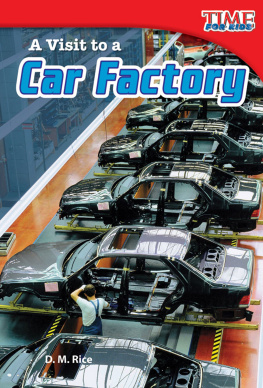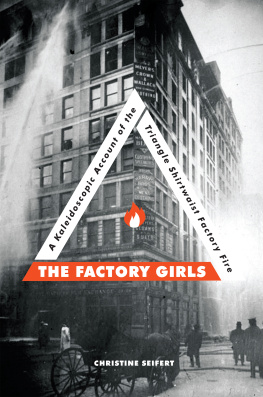Praise for Living and Dying on the Factory Floor
David Ranneys is our best account of the New Lefts turn to the factory and other workplaces in the seventies. Reading in some parts like a novel, it introduces us to a remarkable cast of working-class characters, while offering a refreshingly critical look at his own experiences. We get compelling views of factory work, including the physical dangers and injuries that came with it, as well as a better understanding of a range of New Left organizing efforts. With the experience of a radical organizer and the insights of a very good social scientist, Ranney writes with particular sensitivity about race relations in the workplace.
James R. Barrett, author of History from the Bottom Up & the Inside Out: Ethnicity, Race, and Identity in Working-Class History
Apart from its merits as literatureit made me laugh and weepDaves account of and reflections upon his experience working in the southeast Chicago/northwest Indiana region is valuable to young activists for at least three reasons: 1) It provides information about the nature and significance of the point of production to a generation that has no more knowledge of what it was like than would a Martian. 2) It offers an example of persistence to a generation that tends to measure commitment in days or weeks rather than years or a lifetime. 3) It shows the possibility of personal transformation, both in those like Dave who set out consciously to change the world and in those he met in the course of his efforts to do sotransformation, which is, after all, the whole point.
Noel Ignatiev, author of How the Irish Became White
David Ranney has produced a riveting memoir of his years working industrial jobs on the southeast side of Chicago. Compellingly written and thought provoking, Living and Dying on the Factory Floor brings to life the daily realities of race, class, and gender in an urban community on the brink of joining the rust belt. Ranney pairs vivid depictions of everyday forms of social struggle with timely reflections on the political implications for contemporary readers. This book will be required reading for the next generation of radicals, particularly those hoping to understand how we arrived at the postindustrial gig economy, and how we dismantle it and construct a truly free society.
Michael Staudenmaier, author of Truth and Revolution: A History of the Sojourner Truth Organization, 19691986

Living and Dying on the Factory Floor: From the Outside In and the Inside Out
David Ranney
2019 PM Press.
All rights reserved. No part of this book may be transmitted by any means without permission in writing from the publisher.
ISBN: 9781629636399
Library of Congress Control Number: 2018948939
Cover by John Yates / www.stealworks.com
Interior design by briandesign
10 9 8 7 6 5 4 3 2 1
PM Press
PO Box 23912
Oakland, CA 94623
www.pmpress.org
Printed in the USA by the Employee Owners of Thomson-Shore in Dexter, Michigan.
www.thomsonshore.com
Contents
Preface
And you may find yourself living in a shotgun shack.
And you may find yourself in another part of the world.
And you may find yourself behind the wheel of a large automobile.
And you may find yourself in a beautiful house with a beautiful wife.
And you may ask yourself, well how did I get here!?
Talking Heads, Once in a Lifetime
I find myself sitting at my desk in a rural town in Northeastern Wisconsin looking at chickadees, nuthatches, and chipping sparrows diving in and out of the feeding stations I have set up for my amusement. Indigo buntings, purple finches, and many of the other birds have left for the winter. Suddenly a flock of juncos sails in and begins pecking at the ground beneath the feeders. They come in early spring and leave for the summer, and then stop by in the late fall and leave again for the winter. How is it determined who goes and who stays? How do they mobilize and decide to wing their way from here to there? From their perspective I am on the outside looking in. Yet I feel a connection. As I put up the feeders and keep them full of seeds and suet, many of the regulars sit on or near the feeders chirping happy sounds at me. At this moment, I feel like Im sitting on the inside, looking out at their world.
I am suddenly interrupted from this reverie by an annoying ding from my cellphone. It is a CNN news alert about yet another presidential tweet. In this one the president claims that his proposed tax reform will bring middle-class jobs back to the U.S. For some reason this really sets me off. Feeling angry and agitated, my mind goes back forty years to a time when I was working in a number of factories in Southeast Chicago. It was another time in my life, one when I was both an outsider looking into the world of the factory workers and an insider looking out at the outside world.
I realized that the perspective I gained then is still with me today and accounts for my anger at the simplistic notion of bringing back middle-class jobs. So I began to write about that time in my life, not as a memoir but as an account of life and even death on the factory floor, the raw class and race relations, the exploitation of backbreaking and dangerous labor, and the often unhealthy and unsafe working conditions. Sharing that perspective with others today seems timely and important.
In 1973, I was comfortably employed as a tenured professor at the University of Iowa in Iowa City. It was a time of great optimism and hope that we could replace a society based on greed, sexism, racism, and wars aimed at global domination with something new. I strongly believed, and still do, that we can achieve a totally new society in which the full and free development of every human being is its ruling principle. It would be a society where the measure of wealth would be, in Marxs words, the needs, capacities, enjoyments, and creative abilities of each individual.
As these ideas were forming in Iowa City in the early 1970s, I was highly involved in local political and social activities, including opposition to the Vietnam War, supporting the demands of various civil rights groups, critiquing the political outlook of textbooks used in major survey courses at the University of Iowa, and experimenting with new social forms by organizing cooperative daycare, food co-ops, and housing co-ops. I helped to develop community education events about both the Vietnam War and the Southern African wars for national liberation from colonial powers. The political work and political education were intense and productive, but I increasingly began to feel that we were operating in a bubble that didnt really extend beyond Iowa City. I longed to engage the growing social justice and revolutionary movements all over the world and couldnt really do so from my comfortable perch.
So I took a one-year leave of absence and moved to Chicago, following my Iowa City friend Kingsley, who had opened up a unique pro bono legal clinic he called the Workers Rights Center in a storefront office in Southeast Chicago. Initially I joined a socialist group called New American Movement (NAM) and worked in its national office but later joined the Sojourner Truth Organization (STO) and began working with Kingsley in the Workers Rights Center.
By this time my one-year leave of absence at the University of Iowa had run out and so had my money. I made the difficult decision to leave academia. Many left-wing organizations, STO included, had members working in factories for a variety of reasons. STO believed, for reasons I will discuss at the end of this book, that a new society could be built from the initiatives of mass organizations at the workplace. So it made sense that my financial needs could best be met by working in Southeast Chicago factories. The work was consistent with STO priorities and also engaged the sort of people who were coming to the Workers Rights Center for legal help. This is how I came to work at a number of different factories from 1976 to 1982.
Next page











